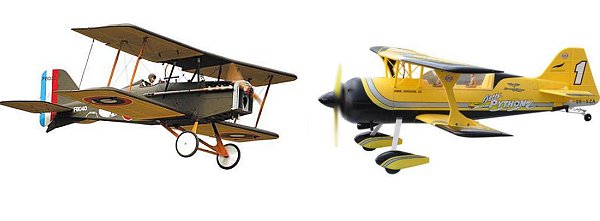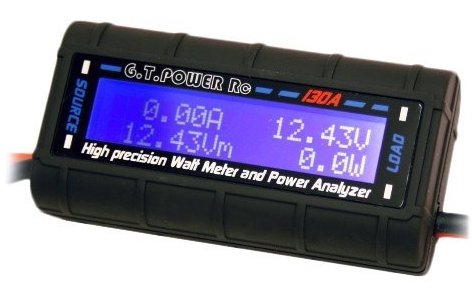The Watts Per Pound Rule
More of a 'rule of thumb' than set in stone, the Watts Per Pound rule is one that lets you determine the power output needed for your electric rc airplane, to give it the performance that you desire.
The rule relates to how many Watts (W) of power are needed per pound (lb) of airplane, and the approximate values range from 50W to 200+W.
It's generally accepted that any plane with less than 50W/lb is going to struggle unless it has a very low wing loading. At the other end of the scale, a powertrain setup that's delivering 200 or more Watts per pound is going to have pretty much unlimited ballistic performance!

Above: A WWI SE5A, left, and a modern Pitts Python.
Both biplanes, but at opposite ends of the Watts Per Pound scale!
General Power Guidelines
Here are some Watts per pound values that should put you in the right ballpark for your particular plane...
- Less than 50W/lb - very lightweight / low wing loading slow flyer.
- 50 to 80 W/lb - light powered gliders, basic park flyers and trainers, classic biplanes and vintage ('Old Timer') type planes.
- 80 to 120 W/lb - general sport flying and basic/intermediate aerobatics. Many scale (eg warbirds) planes suit this power band.
- 120 to 180W/lb - more serious aerobatics, pattern flying, 3D and scale EDF jets.
- 180 to 200+W/lb - faster jets and anything that requires cloud-punching power!
By working around those categories you should be able to decide how much power your rc airplane needs to perform well The categories aren't meant to be exact, but they are very good starting points.
Realistically it all comes down to experimentation as far as actual performance goes. Once you've decided on a suitable motor / powertrain setup that is capable of delivering the required wattage, then play around with propeller selection.
Increasing or decreasing prop diameter and pitch will have a big effect on how your airplane flies, but be careful to stay within the recommended range as stated by the motor manufacturer.
Over-propping an electric rc airplane is one sure way to burn out the ESC because the motor is forced to work harder than it's designed for, and so it tries to draw more current than you calculated the ESC to handle.
Important Point... Remember that for the Watts per pound rule to be effective, you need to weigh the plane in its 'flight ready' state. This is commonly known as the All Up Weight (AUW) and just means that you should be weighing the plane with the flight pack in place.
What's a Watt?
A Watt is the correct unit to measure electrical power and Watts are calculated by multiplying the voltage (V) by current in amps, for which the proper symbol is 'I' but you'll also likely see it written as 'A'.
So, VxI=W or VxA=W.
If you're looking for the IC (internal combustion) equivalent, 1hp (horsepower) is equal to 746W.
Using a Watt Meter
The only sure-fire way to determine how much power your particular setup is producing is to use a Watt meter.
This useful little tool (actually essential if you do want to start experimenting with different EP setups) connects between the flight pack and ESC, and will give you various readings throughout the power range.
Simply connect it up and power up your plane, and read off how many Watts are being produced.

Above: an RC Watt meter is essential once you get in to
doing your own electric power setups.
Watt meters take all the guesswork out of electric plane powertrain setups, and for the little money they cost will give you a lot of peace of mind.
Weight or Wing Loading?
It's worth noting that although the Watts per pound rule works on the actual flying weight of the airplane (AUW), the more realistic and accurate reference to a plane's performance in relation to its flying weight is called the wing loading.
Wing loading is a value expressed (for model planes) in ounces per square foot (Oz/ft²) or grams per square decimeter (g/dm²), and is the flying weight of the plane divided by the total wing area.
The larger the wing area and lighter the plane, then the lower the wing loading will be and vice versa.
A lower wing loading means slower take off capability and better flying performance in many ways. But for the purpose of calculating power requirements for your model, in terms of the Watts per pound rule, work with the actual weight of it and don't worry about wing area or loading.
If you're a complete beginner to the hobby with your first RTF rc plane, then you won't need to worry about Watts per pound or wing loadings just yet. But as you get more in to the hobby, do take the time to understand and know how to use these important calculations.
